Magento 2 Backend Exploration: Orders
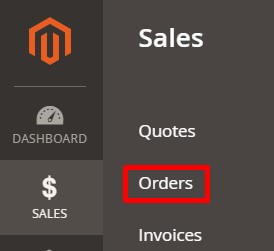
In the following article, we teach you how to manage the Orders screen, add new orders on behalf of your customers, as well as import and export orders. This tutorial suits both Magento 2 Commerce and Open Source users. Let’s see what actions can be applied to orders in your Magento admin.

Table of contents
- 1 Magento 2 Orders Screen
- 2 Magento 2 Order View
- 3 How to Create a New Order in Magento 2
- 4 How to Import Orders to Magento 2
- 5 How to Export Orders from Magento 2
- 6 Improved Import & Export Features
- 7 Final Words
Magento 2 Orders Screen
You can find the Orders screen under Sales -> Orders.
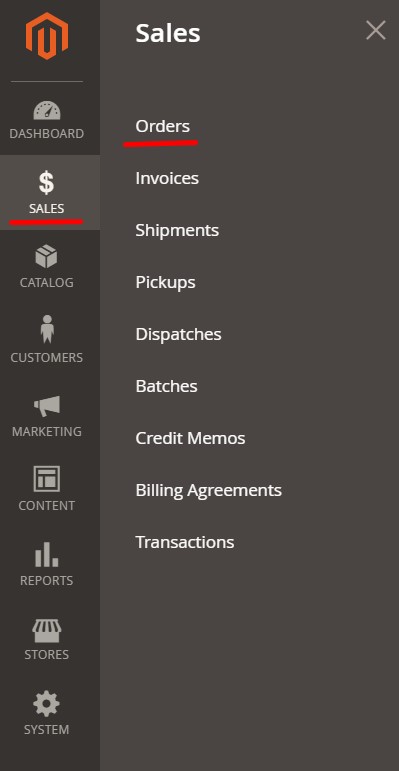
Control Elements
The corresponding page contains numerous standard control elements of the Magento 2 admin.
You have a search field on the top left part of the screen. A dropdown with actions is available below. You can apply the following measures for multiple orders simultaneously: cancel, hold, unhold, print invoices/packing slips/credit memos/shipping labels/all documents, batch processes, etc.

The top right area above the Orders grid lets you apply filters, switch between grid views, show/hide columns, export grid content, select the number of orders per page and switch between grid pages.
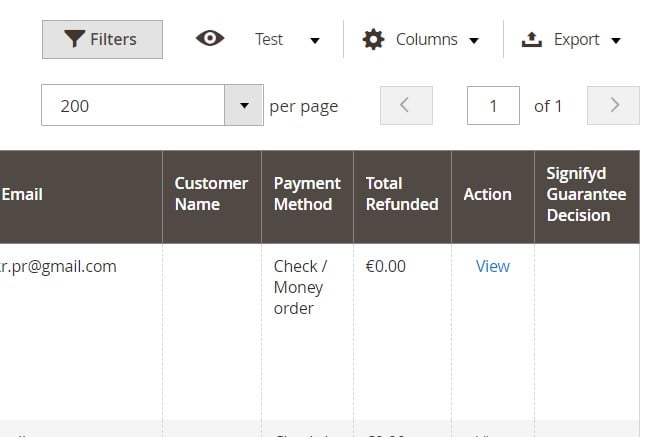
You can use the search field to find orders by their number, customer, or customer email. Just type a keyword and hit the Enter button. Below, you can see all orders that belong to a customer named Kumar:

To apply mass actions to orders in Magento 2, you have to select orders you want to manage – tick them in the first column manually (you can also choose Select All, Deselect All, Select All on This Page, or Deselect All on This Page from the dropdown in the first column) – and select an action you want to apply from the Actions dropdown:

Below, you can see the section with filters. It lets you narrow down the selection of orders in the grid by specifying particular purchase dates, grand total, refunds, purchase point, order ID, bill-to and ship-to name, order status, customer name/email, payment method, or signified guarantee decision status.
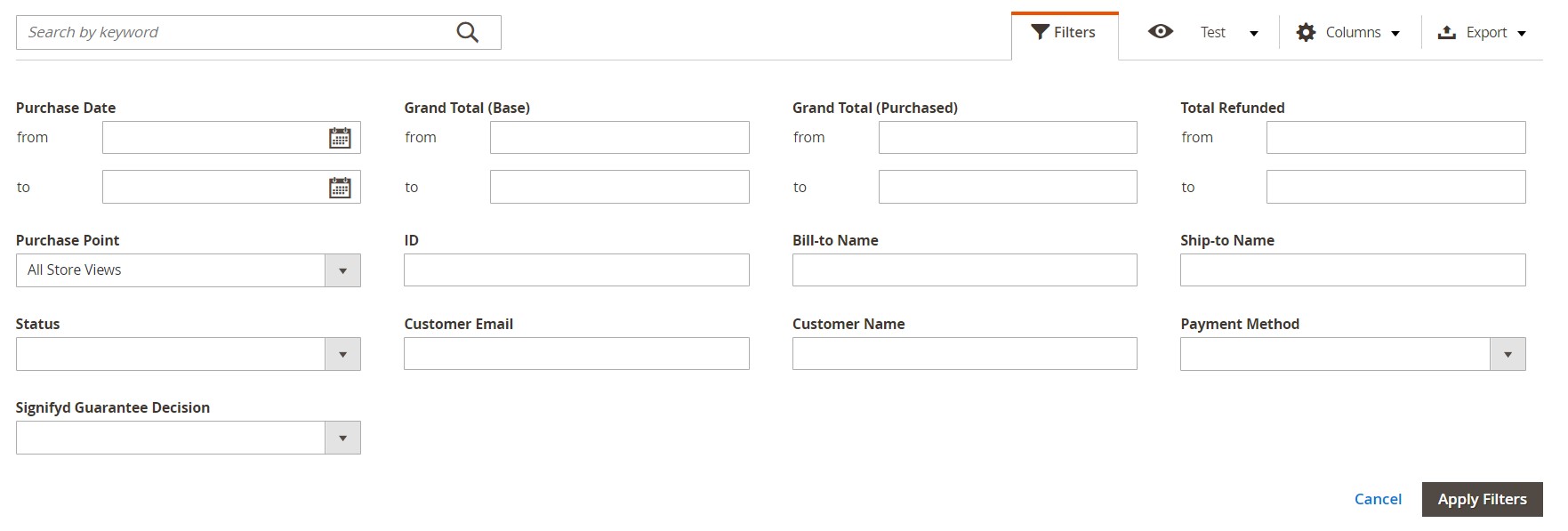
You can show/hide the following 20 columns:
- ID;
- Purchase Point;
- Purchase Date;
- Bill-to Name;
- Ship-to Name;
- Grand Total (Base);
- Grand Total (Purchased);
- Status;
- Billing Address;
- Shipping Address;
- Shipping Information;
- Customer Email;
- Customer Group;
- Subtotal;
- Shipping and Handling;
- Customer Name;
- Payment Method;
- Total Refunded;
- Action;
- Signifyd Guarantee Decision.

After changing the appearance of the grid, you can save it as a new view:
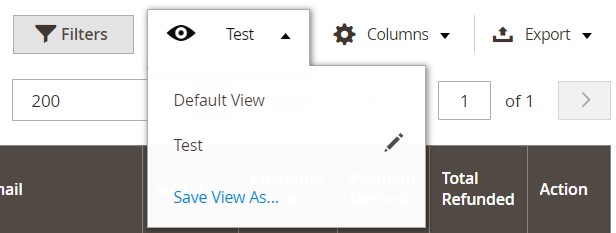
The Default Orders Grid View
The default view includes the following columns:
- Checkboxes – select orders for mass actions;
- ID – view order IDs;
- Purchase Point – a part of your website where an order was placed;
- Purchase Date – time when an order was placed;
- Bill-to Name – a name of your customer specified in order details;
- Ship-to Name – a name of your customer specified in order details;
- Grand Total (Base) – value in the default store currency;
- Grand Total (Purchased) – value in the corresponding store view currency;
- Status – an order status: Processing; Suspected Fraud; Pending Payment; Payment Review; Pending; On Hold; Open; Complete; Closed; Canceled; PayPal Canceled Reversal; Pending PayPal; PayPal Reversed, etc;
- Action – view orders;
- Signifyd Guarantee Decision – automated order reviews for fraud; the system indicates which orders to ship, and which to reject.
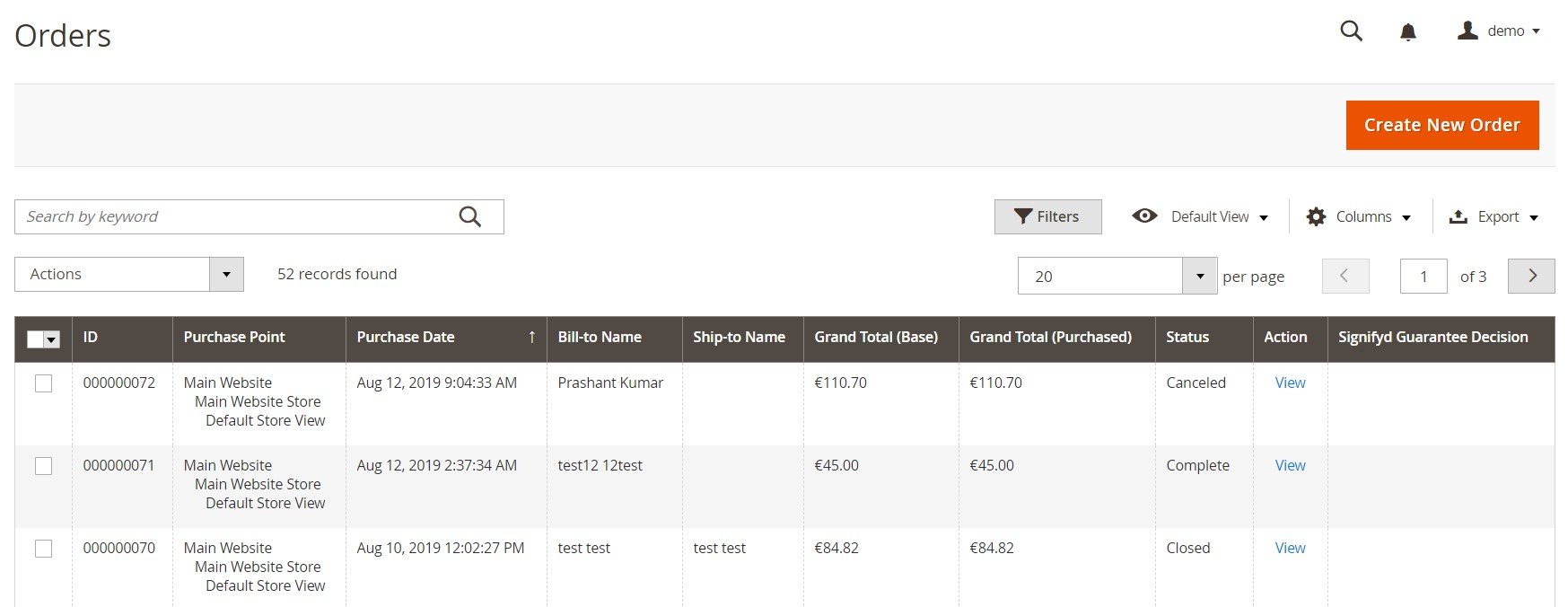
Magento 2 Order View
An order view page consists of 5 tabs: Information, Invoices, Credit Memos, Shipments, and Comments History.
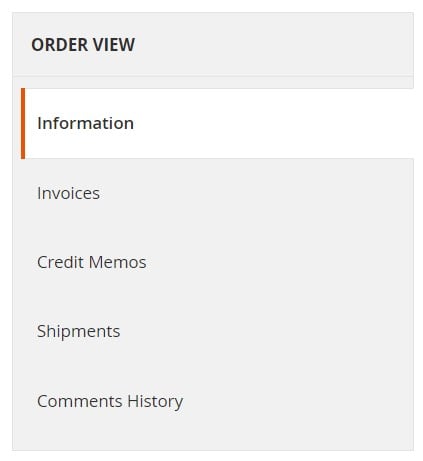
Information
The information tab is divided into the following sections:
- Order & Account Information;
- Address Information;
- Payment & Shipping Method;
- Items Ordered;
- Order Total.
Order & Account Information
In Order & Account Information, you can view order date, status, purchase point and IP, as well as customer name, email, and group.

Address Information
In Address Information, you can view and edit billing and shipping addresses.

Payment & Shipping Method
In Payment & Shipping Method, you can view payment details as well as shipping and handling info.

Items Ordered
Items Ordered includes all items available from the order. You can view such information as product information and SKU, item status, original and current prices, item quantity, subtotal, tax, discount, etc.

Order Total
In Order Total, you can view and change an order status as well as view and leave comments, sending notifications to a customer and making them visible on a storefront. Besides, order totals are displayed here:
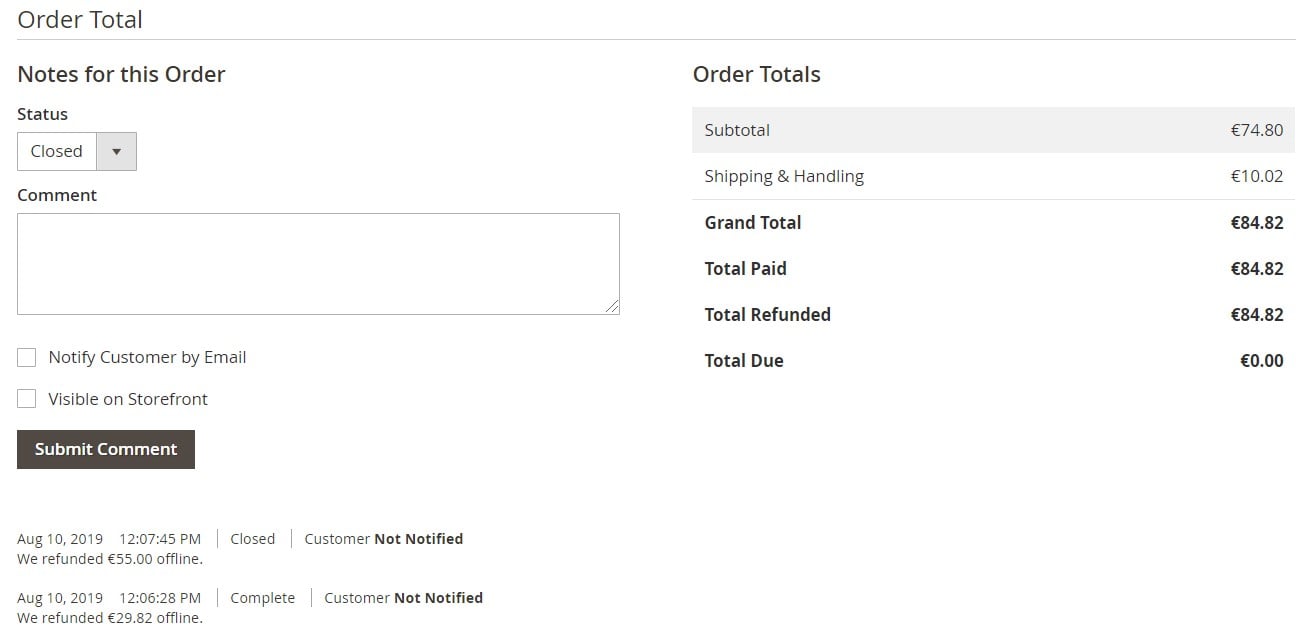
Invoices
Invoices is a standard Magento 2 screen with a grid and corresponding control elements: search, mass actions, filters, columns, page view, export, etc.

Credit Memos
This screen is similar to the one mentioned above:

Shipments
Shipments is not an exception, you can see it below:

Comments History
This tab lets you view all actions applied to the order as well as see notes added on the first tab.
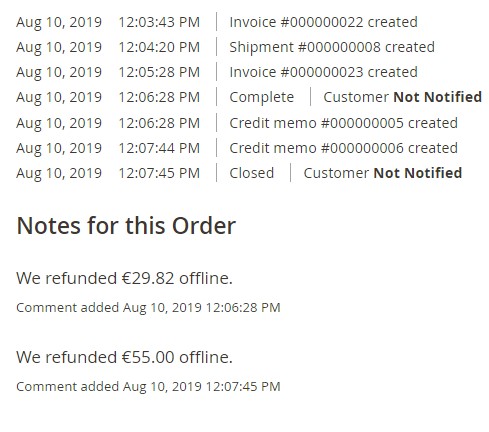
How to Create a New Order in Magento 2
Now, let’s explore how to create a new order in Magento 2.
Go to the Orders screen under Sales->Orders and hit the “Create New Order” button.

You will be redirected to a new screen, where you should select a customer from a grid or create a new one to create an order for them.
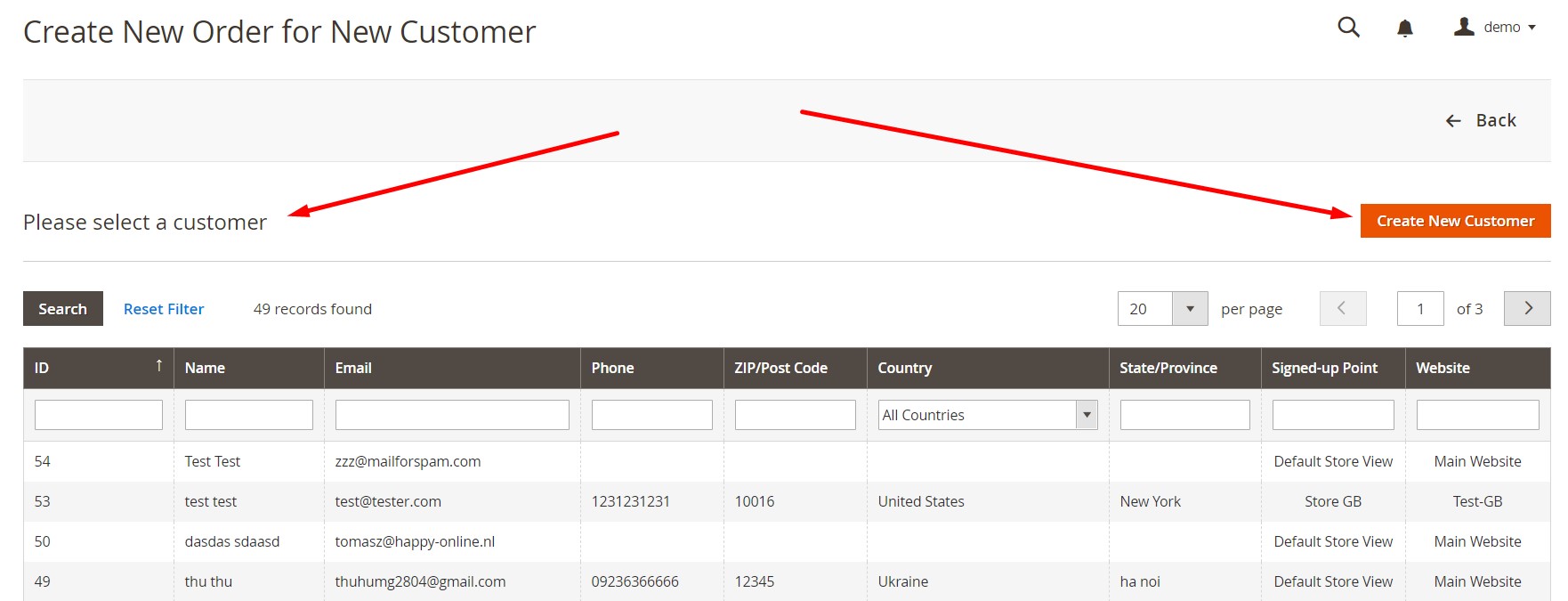
Next, select a store to associate the new order with.
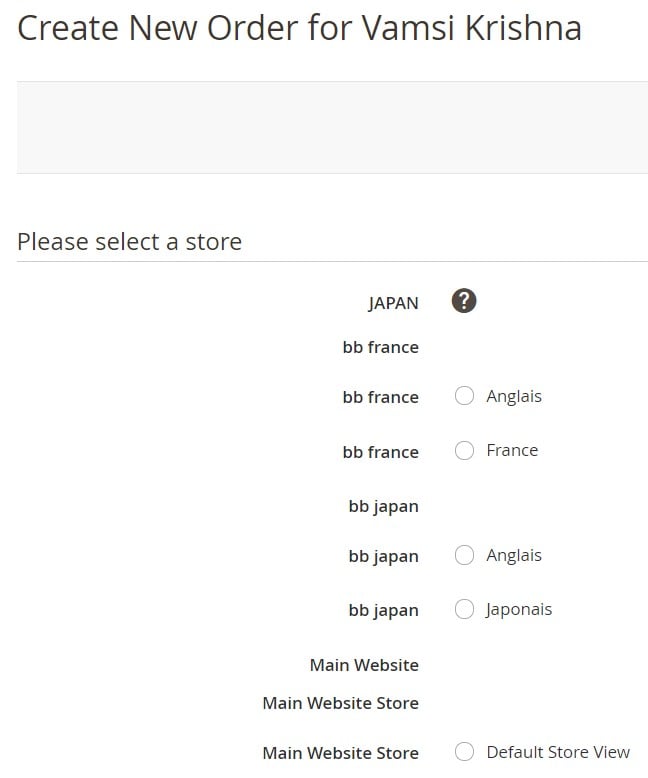
Now, you are on a major order creation screen.
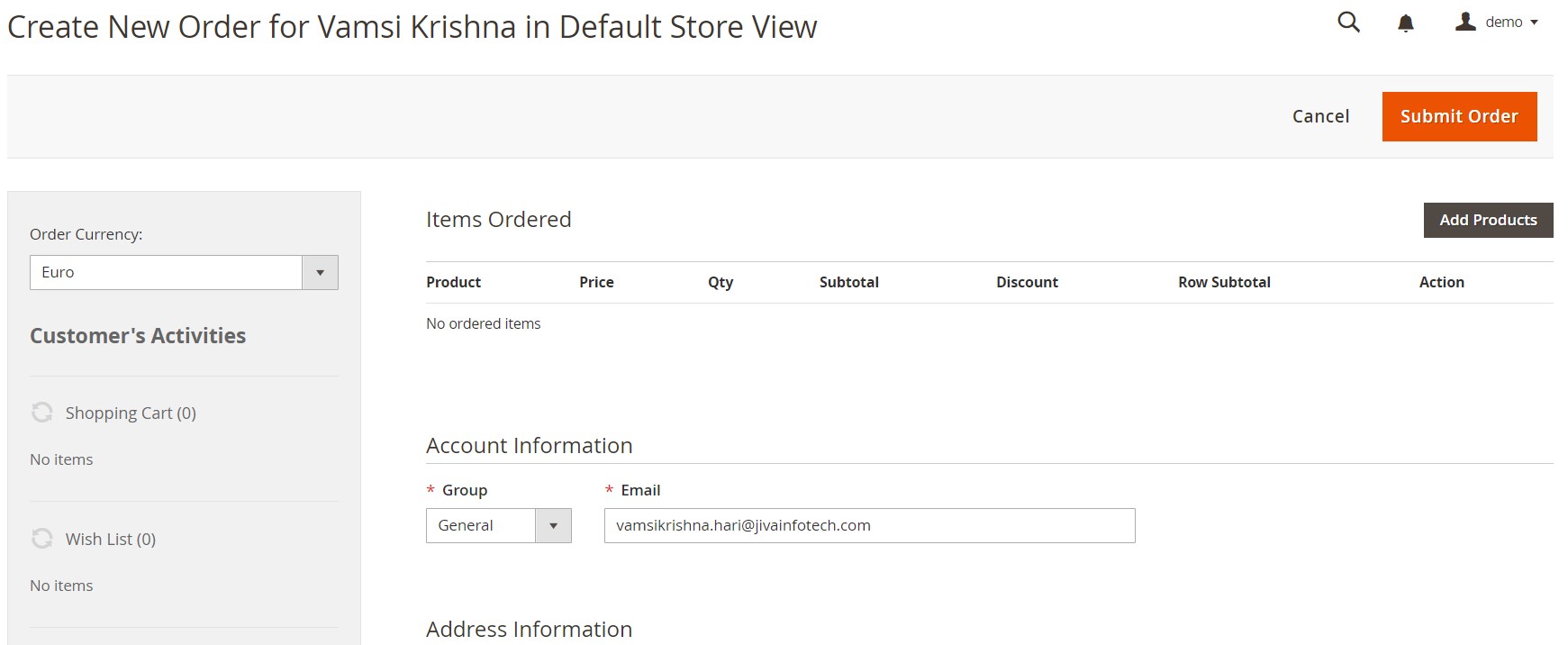
On the left, there is a block where you can select an order currency as well as add items on the basis of the following customer’s activities:
- Shopping cart items;
- Wish list items;
- Last ordered items;
- Products in comparison list;
- Recently compared products;
- Recently viewed products.
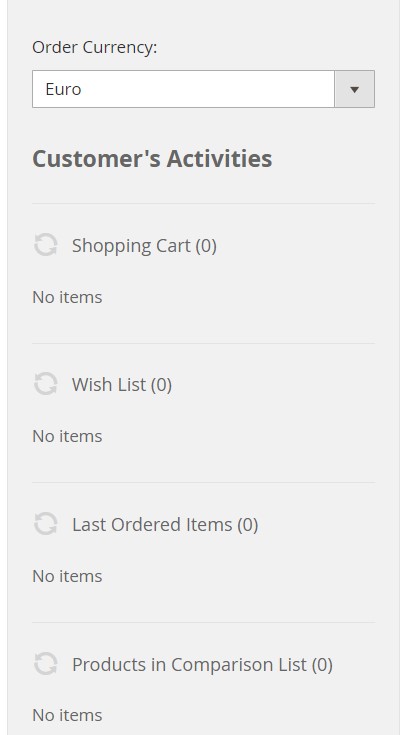
Next, add products to the cart. Hit “Add Product” on the top right and choose items from the table; specify their quantity.
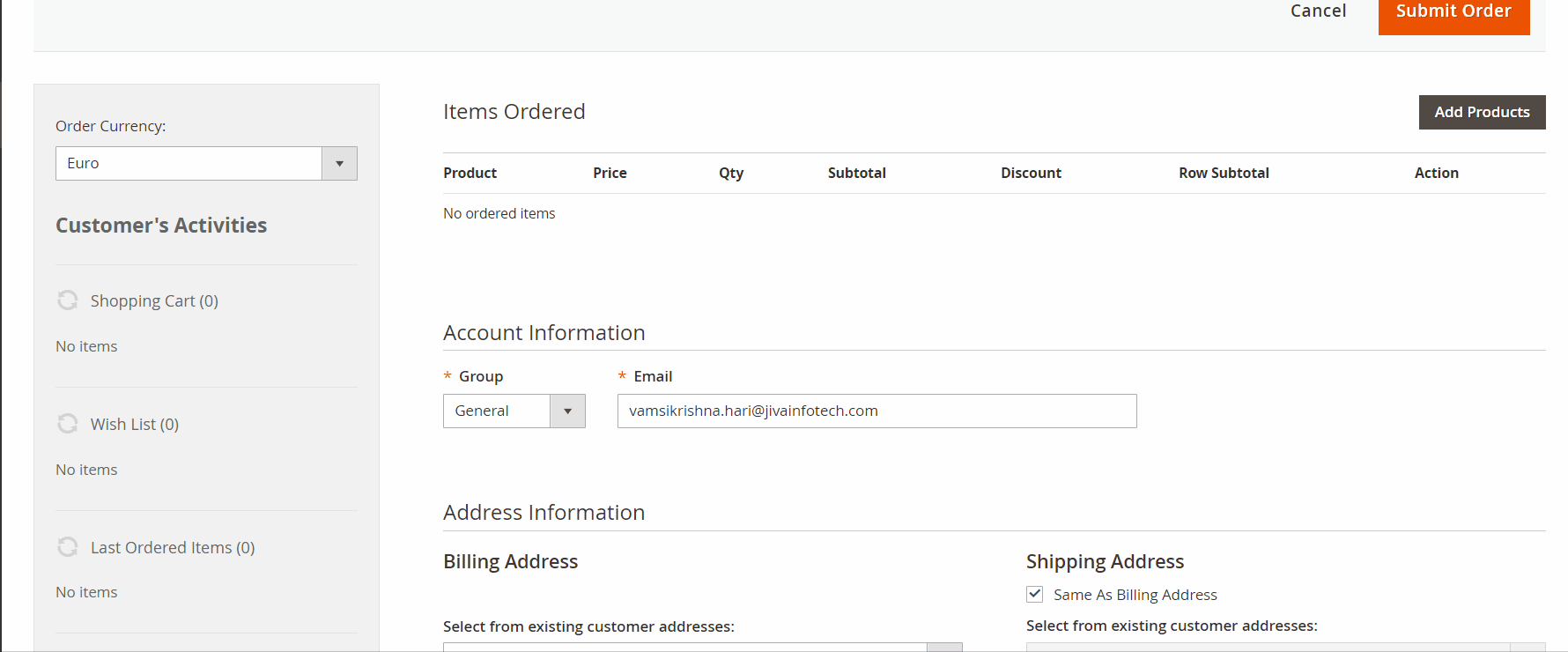
When all products are added, proceed to the Account Information section. Here, you can select a customer group and specify an email address.

Now, you can specify address information. If shipping and billing addresses are the same, you can type only billing details. To fill in shipping address fields automatically tick the corresponding feature:
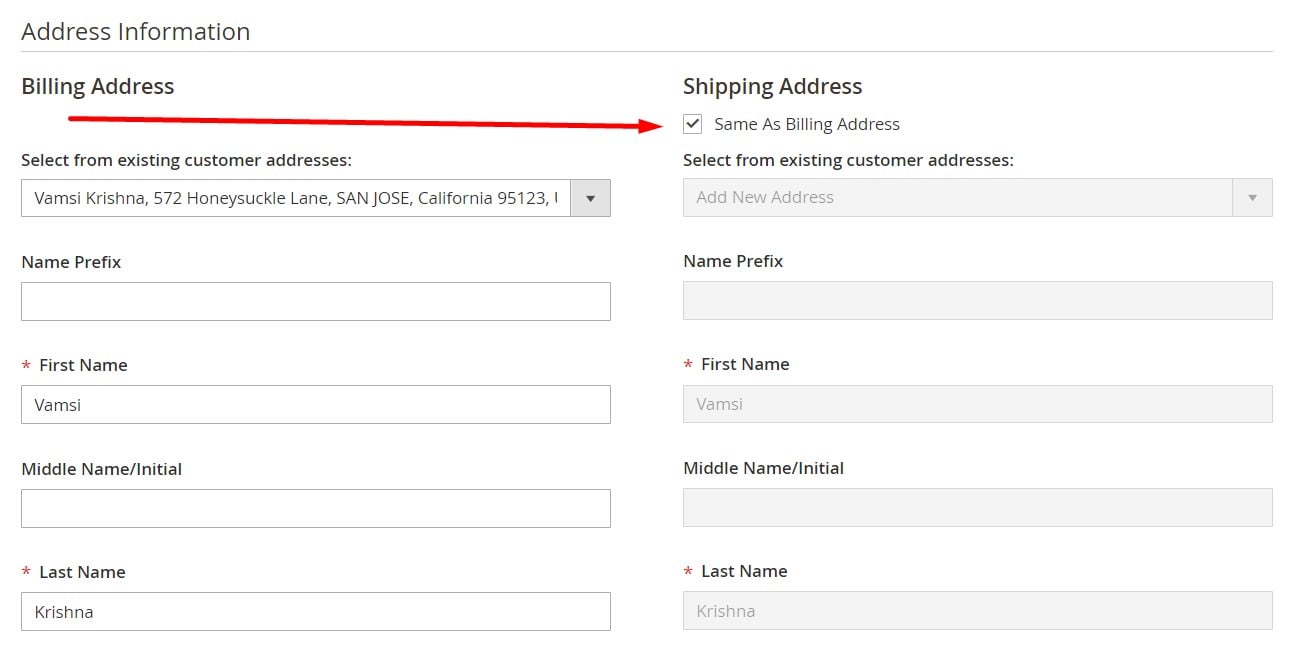
Next, choose shipping and payment methods.
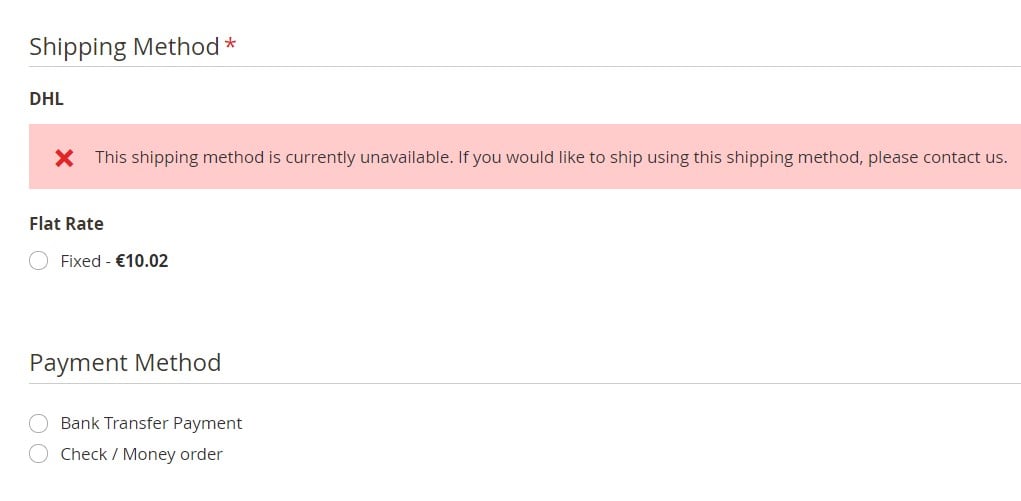
You can also add order comments and view order totals.
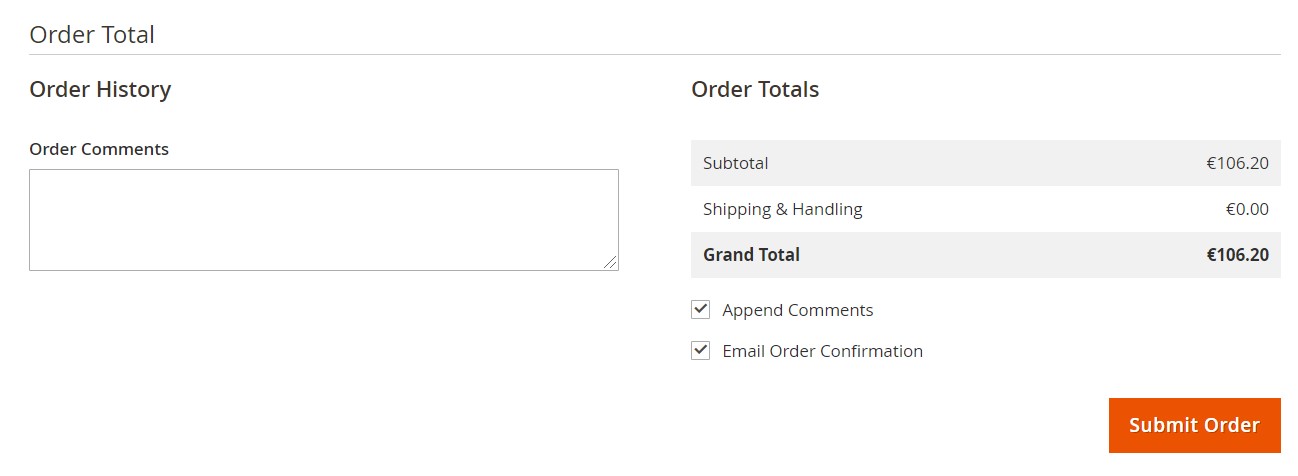
Don’t forget to submit order when all products are added, and the required data is specified.
How to Import Orders to Magento 2
To import orders to Magento 2, we recommend you to use the Improved Import & Export Magento 2 extension. This module not only automates the default order import process but also lets you transfer all the related data from any external system. Let’s imagine that you are migrating from your old Magento 1 website to a brand new Magento 2 store. Create an export file with orders on your old site. Next, transfer it to a server or a dropbox account. Then, follow these steps:
Go to System->Improved Import/Export->Import Jobs and hit the “Add New Job” button.
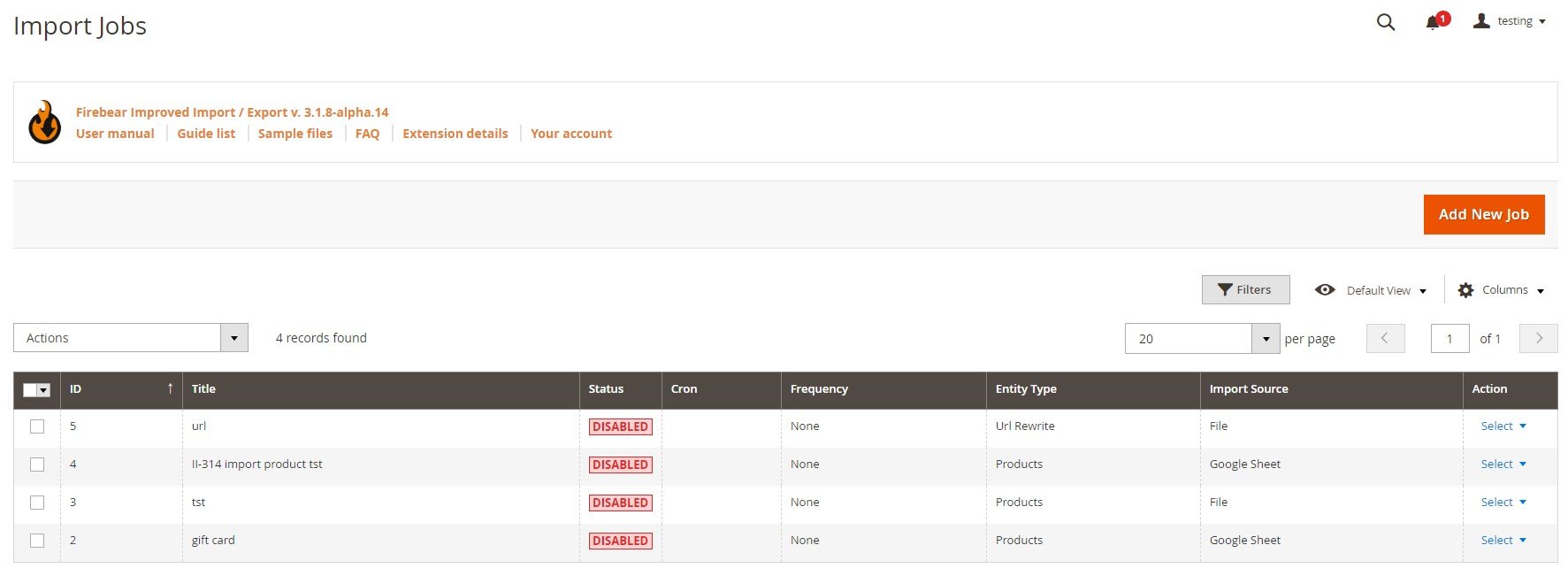
In General Settings, enable the job, specify its title, choose the manual run frequency (we are transferring data from your old store, so it is a one-time procedure), select a language (locale), and enable/disable the following features depending on your business needs:
- Generate Unique Url if Duplicate;
- Re-Index after Import;
- Send email from new tracks.
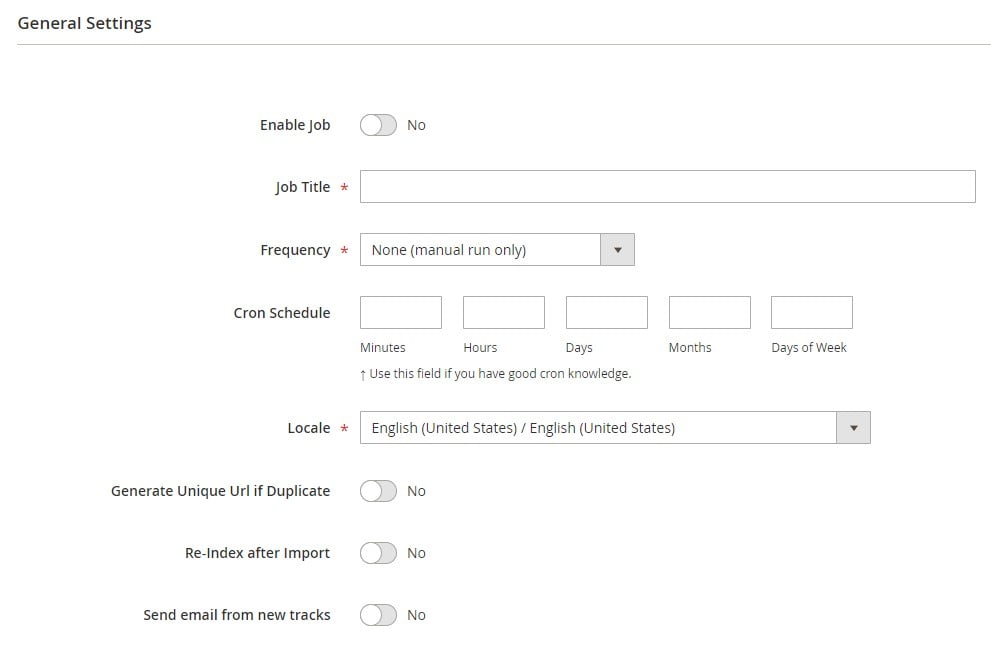
In Import Settings, disable API (we are going to transfer orders via CSV from your old Magento 1 website), choose Orders in the Entity dropdown, and select a platform.
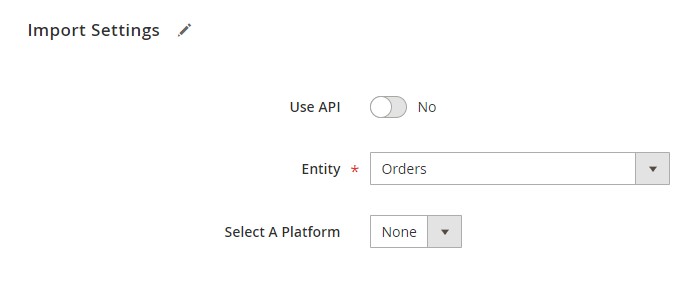
In Import Behavior, select Add/Update from the dropdown, choose a validation strategy, specify the maximum possible number of errors, and type separators.
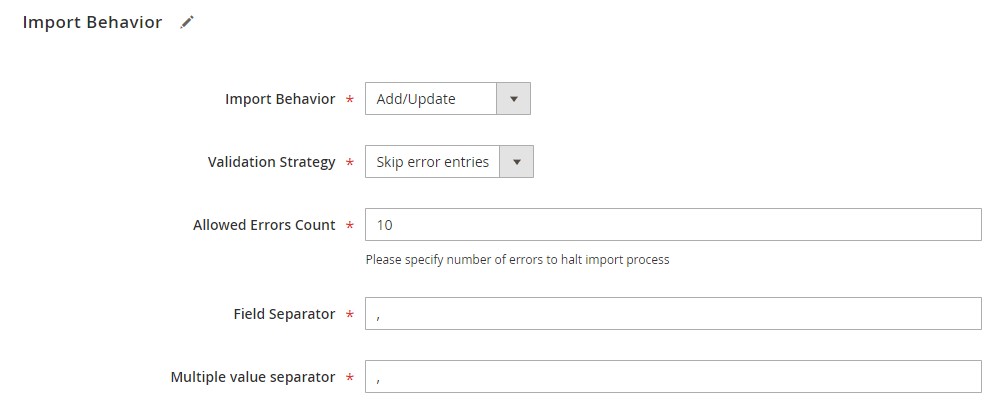
In Import Source, select CSV as your import file type (or choose another standard if your data file is not CSV). Next, specify your import source. You can import a data file from a server, Dropbox account, URL, or upload it directly. In the case of Dropbox, specify a file path, access token, and remote images directory. Enable/disable the following features depending on your business needs:
- Use Image Import Source;
- Do you want to remove current mappings?
And don’t forget to validate the data file with orders. If it contains attributes that are not supported by Magento 2, you can apply mapping. We will describe this feature further in this article.
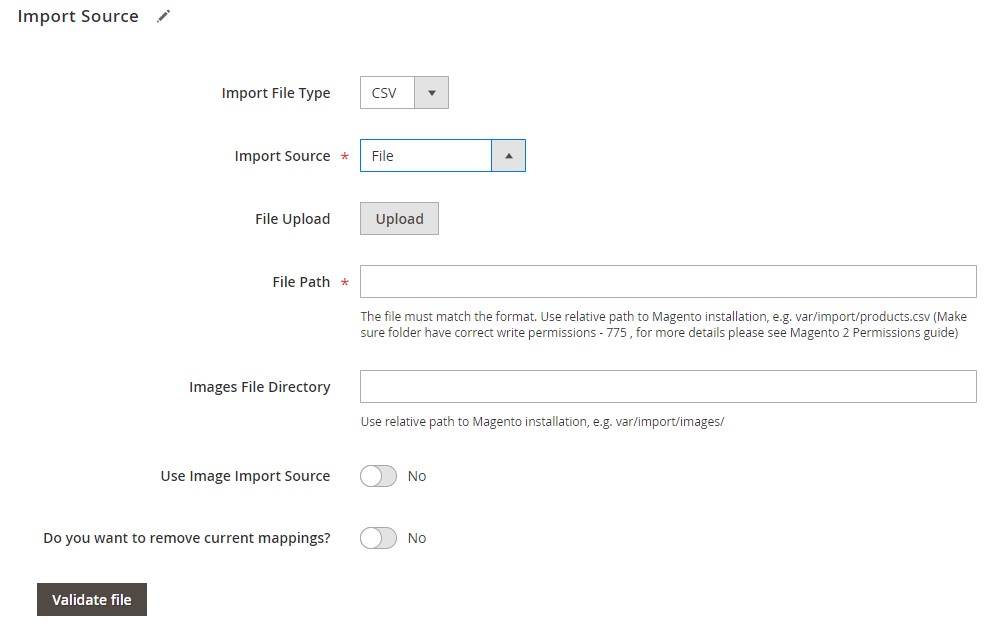
To start the import process, hit “Save & Run” in the top right corner of the screen. For further information about order import in Magento 2, follow the link below and contact our support:
Get Improved Import & Export Magento 2 Extension
How to Export Orders from Magento 2
To export orders from Magento 2, we recommend you to use the Improved Import & Export Magento 2 extension. This module not only automates the default order export process but also lets you transfer all the related data to any external system without modifying data files manually. Let’s imagine that you need to provide an ERP system with order data on a daily basis. Follow these steps to achieve your goal:
Go to System->Improved Import/Export->Export Jobs and hit the “Add New Job” button.
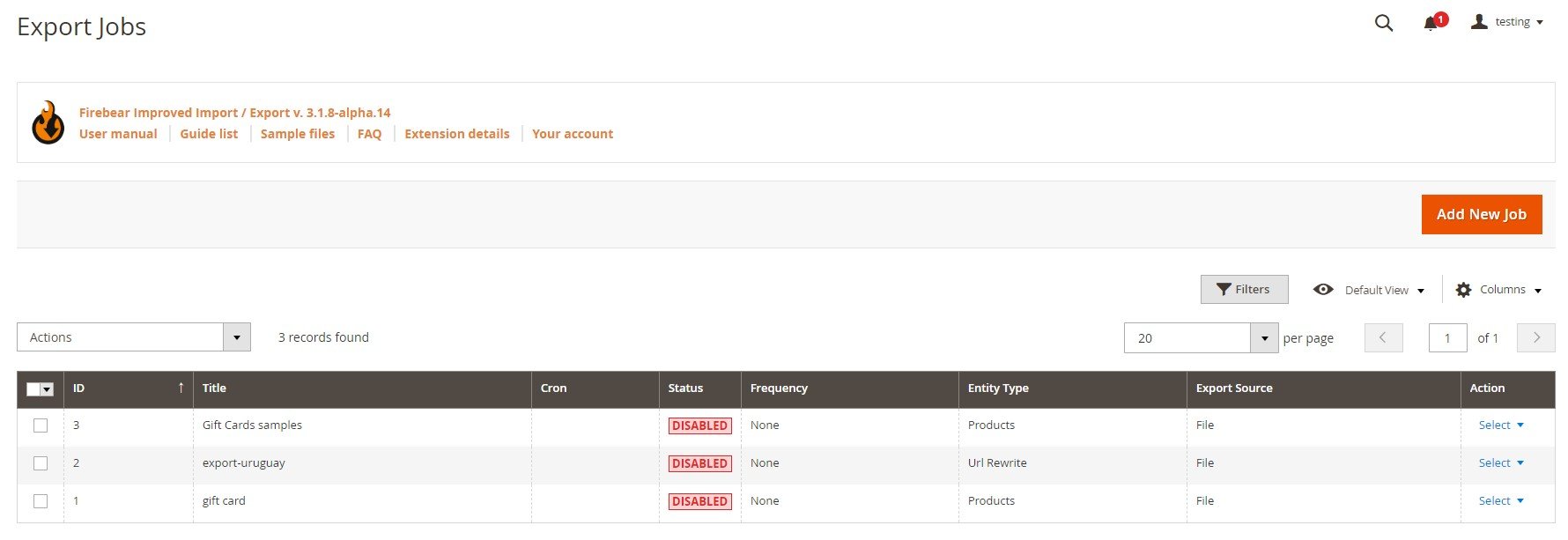
In General Settings, enable the job, type its title, and select a frequency (every day at 3:00am). Choose a local file language and divide additional attributes if necessary.
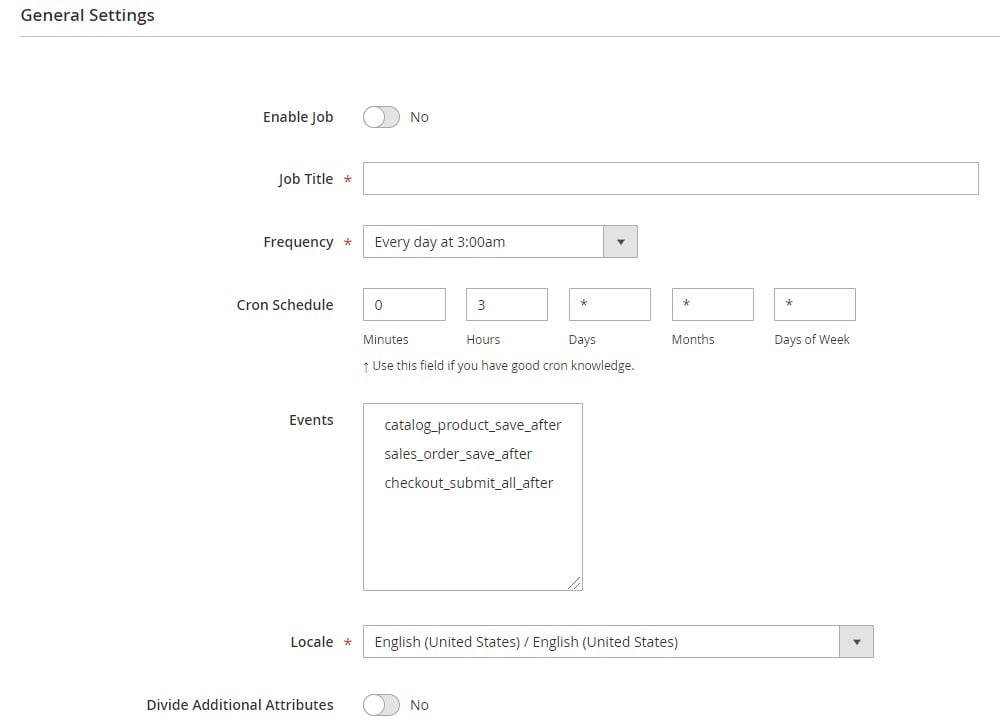
In Export Settings, select Order from the Entity dropdown and enable Consecutive Export.
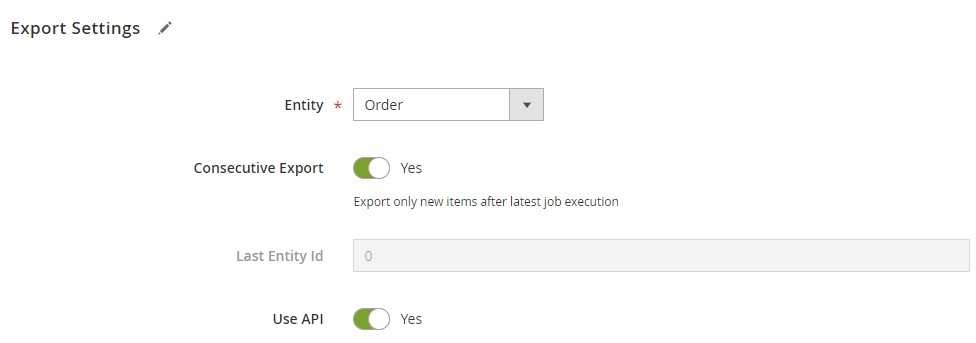
In Export Behavior, select a format of your order export file (your ERP system should support this format) and choose order entities that should be provided to the external platform.
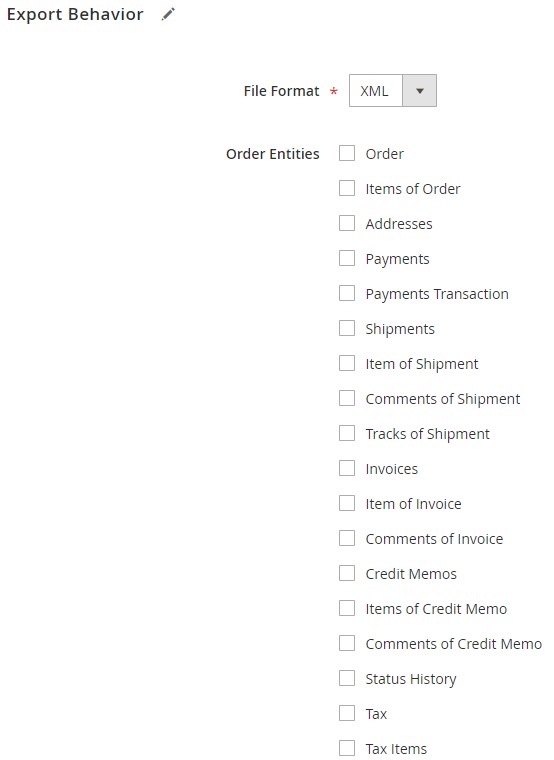
In Export source, specify where your orders should be transferred to. You can select FTP, SFTP, or a data file as a destination. Check the connection before going any further.
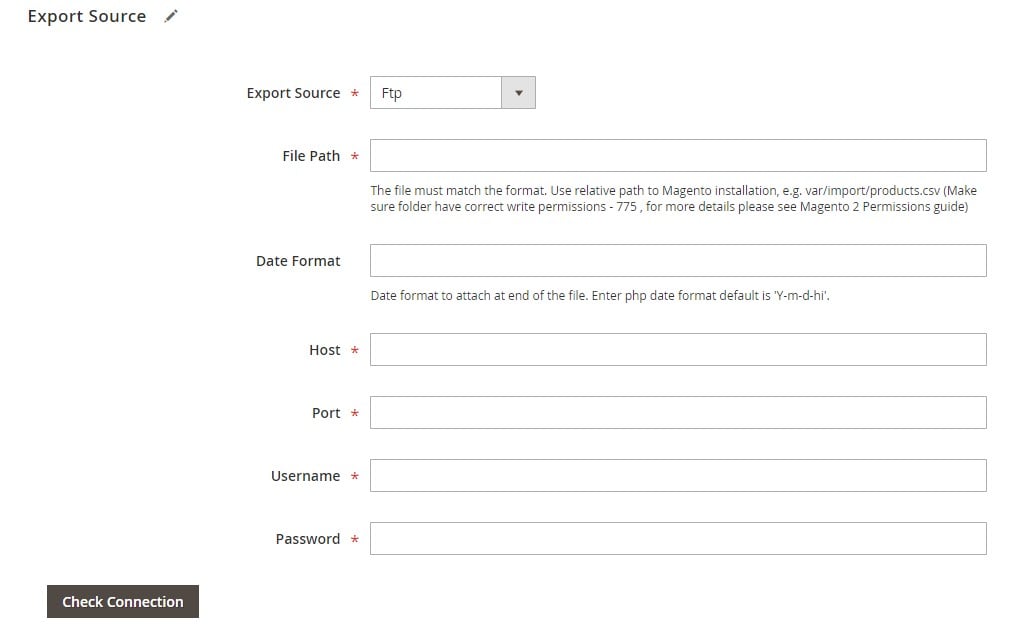
Next, you can map attributes and add filters.
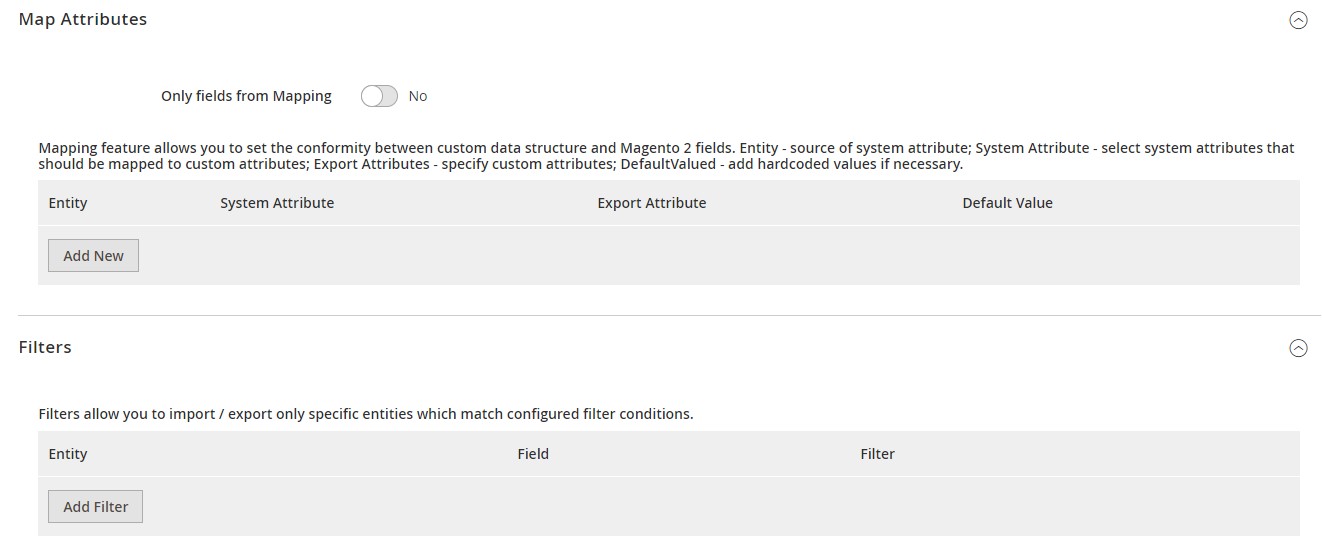
To start the export process, hit “Save & Run” in the top right corner of the screen. For further information about order export in Magento 2, follow the link below and contact our support:
Get Improved Import & Export Magento 2 Extension
Improved Import & Export Features

Now, let’s pay a little bit more attention to the features of the Improved Import & Export extension. The tool is designed to turn your Magento 2 admin into a central hub where you control all integrations; therefore, it is much more potent than any import/export solution currently available on the market. Even the default transfer tools of Magento 2 Commerce don’t offer anything similar.
The extension provides several ways of moving order data to and from your e-commerce website, including a direct connection between two systems. As an admin, you can manage all integrations right in the backend interface. And as it was mentioned above, the plugin allows automating all order import and export processes. Let’s start the exploration with this feature.
Automated Import & Export Processes
The Improved Import & Export Magento 2 extension offers two different ways of automated order data import and export: schedules and event-based triggers. The principle behind both mechanisms is described below. You only have to configure your import/export job, and the extension does everything for you. Let’s see how schedules work.
Schedules
With the Improved Import & Export Magento 2 extension, you can use the default cron syntax to create export schedules moving Magento 2 orders to a remote platform. The module provides the ability to specify any custom intervals so that you can create a schedule suitable for your specific business needs. At the same time, you can select one of the predefined intervals which are also fully customizable – just like in the order export example above. Select a value that seems to be suitable and modify it according to your business requirements.
And don’t forget about the opportunity to create import and export profiles which have no schedules. If you only need to move data once, like in the order import case described above, there is no need to schedule the profile.
Another cool feature related to schedules is the ability to launch every profile manually. For instance, you need to transfer orders to an external system every day at 6 PM, but no orders have been placed yet. If the first order has been placed after 6 PM, you can easily move it to an eternal system manually. Besides, asynchronous updates let you avoid delays when a partner provides a file with orders after a scheduled event.
With the Improved Import & Export Magento 2 extension, it is possible to transfer all data to and from your database manually within just a few clicks. It is no longer necessary to wait for the next planned import/export event. As for the configuration of a schedule, it looks as follows:

Events
Event-based triggers represent the second way of automating data transfers in Magento 2. The Improved Import & Export extension enables real-time updates based on them. Create and configure a trigger specifying conditions to synchronize two systems right after a certain action takes place.
Let’s explore the aforementioned example of Magento 2 order export. With event-based triggers, you can select an event that launches the corresponding data transfer process. In our situation, it is a newly placed order. The plugin considers this event a trigger and starts order export right after the specified event. Thus, data is provided to a remote platform in real-time.
The same approach can be applied to import processes as well. For further information, check this article: How to Run Magento 2 Import or Export After Specific System Event or Process.
Advanced Mapping Features
The following chapter discusses another important aspect of the Improved Import & Export Magento 2 extension – the ability to solve problems caused by different attribute standards. Our module provides several exclusive mapping features that dramatically simplify both import and export procedures.
It’s no longer necessary to edit attributes and their values manually in a data file. If exporting order data with Magento 2 attributes won’t interrupt the transfer, it may cause multiple headaches when you try to provide the file to an external system. That’s why mapping may save lots of time and effort.
Besides, our extension offers handy tools for matching attribute values and even categories as well as generating missing elements of a data file right during the import. Once configured, a mapping scheme is saved and utilized for further updates, so you can automate order data export to a remote system.
Mapping Presets
The Improved Import & Export Magento 2 extension offers a very straightforward way of matching external attributes to ones used internally. You get a series of mapping presets – predefined mapping schemes that provide the ability to implement attribute matching in a few clicks. After creating and configuring a new job, choose a suitable preset in the mapping section of your new profile. Next, the Improved Import & Export Magento 2 extension will do all the work for you.
Instead of figuring out what third-party attributes are utilized in your order file, you let our module analyze the input data and match all third-party designations to the internal ones. Any manual interactions with data files are eliminated. Here is how everything happens in the admin:

Matching Interface
If there is no preset suitable for your integration or you want to make an import/export file suitable for third-party requirements manually, utilize the matching interface of the Improved Import & Export Magento 2 extension. It lets you map attributes by yourself but your admin replaces a third-party editor. The procedure is fast and intuitive: select an entity, choose a system attribute and specify the corresponding external one in front of it as shown below:
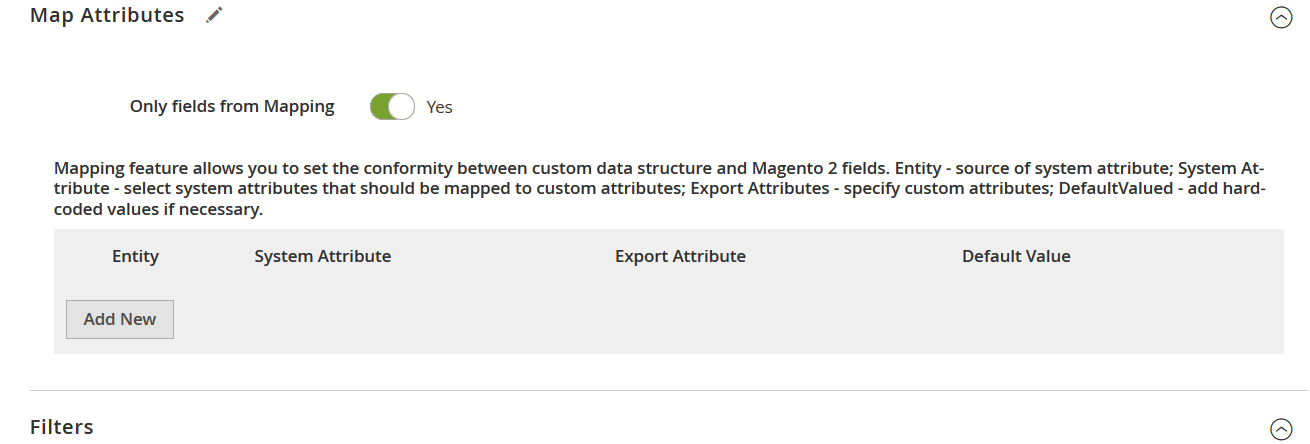
In the grid above, there is also the third column – “Default Value” – where you can specify hardcoded (default) values, which are attribute values automatically provided to every item related to the attribute. It is handy when, for instance, you import products from multiple store views to a single one.
Filters
Now when you know how to apply mapping and use hardcoded (default) values, we’d like to describe another feature that lets you export Magento 2 orders to a remote system – filters. Follow these steps to master the tool:
- Click the ‘Add Filter’ button;
- Select an entity;
- Select a system attribute that will be used as a basis of a new filter;
- Specify parameters applied for filtering;
- Repeat the previous steps to create more filters.
Note that parameters applied for filtering vary, depending on the chosen attribute. Everything is simple and intuitive:

Attribute Values Mapping
Besides, the Improved Import & Export Magento 2 extension provides the ability to match attribute values. Since incorrect values may prevent import processes or may not be accepted by third-party systems, it is essential to replace all unsupported designations with the proper ones. As you might have already guessed, the default Magento tools don’t let you do that.
As for our plugin, it offers an interface similar to the one we’ve just described above. Choose a third-party designation and specify a corresponding internal one in front of it. Repeat matching until no external values are left. For further information, read this article: Attribute Values Mapping.
Attribute Values Editing
The Improved Import & Export Magento 2 module lets you not only map attribute values but also edit them in bulk. The extension provides the following rules that can be combined and applied to multiple values simultaneously:
- Add a prefix to multiple attribute values;
- Add a suffix to multiple attribute values;
- Split multiple attribute values;
- Merge multiple attribute values.
Note that the module provides the ability to create various conditions to increase the efficiency of editing. For further information, check this article: How to Modify Attribute Values During Import and Export in Magento 2.
Category Mapping
Another feature of the Improved Import & Export Magento 2 extension that simplifies the way you import data from any source is category mapping. It is especially useful when you transfer data from third-party catalogs that have a unique structure. Thus, you cannot freely import the update without editing third-party categories manually or applying changes after the data is transferred unless you use our plugin.
The Improved Import & Export extension provides the ability to match external product categories to ones used internally in a fast and intuitive manner. You apply all the changes in a single place of your admin. The process looks as follows:

In addition to mapping, it also allows creating new categories on the fly. The Improved Import & Export Magento 2 module lets you select a parent category and specify a new one related to it. Both features are described here: Category Mapping.
Attributes On The Fly
Another feature that dramatically simplifies import processes is the ability to create attributes on the fly. If an update file doesn’t include all the necessary data, our module allows using the following general form to specify all parameters used to get all missing attributes automatically:
Attribute|attribute_property_name:attribute_property_value|…
The procedure is described in more detail here: Product attributes import.
Extended Connectivity Options
As mentioned above, the Improved Import & Export Magento 2 extension allows extending the default opportunities related to data transfers. In addition to support for a remote server, our module offers a bunch of other extended connectivity options.
Multiple File Standards
You are no longer limited to CSV files – the only standard supported by Magento. The Improved Import & Export Magento 2 extension lets you use XML, JSON, ODS, and Excel files instead. Thus, the necessity to convert files of these standards into CSV and vice versa is completely eliminated! You can always apply all features described above to any of these file types.
Multiple File Sources
And the vital improvement that enables order file import/export is support for multiple sources. The Improved Import & Export Magento 2 extension lets you leverage several different connection options:
- FTP/SFTP. Transfer data files using a local or remote server.
- Dropbox. Use a Dropbox account to establish a connection between the two systems. Alternatively, you can rely on Box, OneDrive, Google Drive, iCloud, and Amazon Drive.
- URL. A direct URL can be used to import a data file as well.
In case an update file is compressed, you don’t need to extract it before the import. The Improved Import & Export Magento 2 extension will do everything for you!

Alternative Ways of Import & Export
Note that the alternative ways of import and export are not represented in Magento 2 by default. However, direct API connections are the only way to enable the Magento 2 integration with most external platforms.
As we’ve mentioned above, the Improved Import & Export extension provides the ability to leverage REST for the Magento 2 ERP synchronization as well as other APIs if necessary. For instance, it works with SOAP and GraphQL. Note that all API connections support other extension’s features.
As for the intermediary services, you can rely on Google Sheets, Office 365 Excel, and Zoho Sheet transferring data to your e-commerce store. The following image shows how to use Google Sheets to move data to Magento 2:

And of course, the Improved Import & Export extension opens completely new possibilities with support for WSDL and WADL.
The video below displays other details of our extension:
Final Words
Now, you know how to create orders in Magento 2. You must admit that importing/exporting them is no longer a problem if you use Improved Import & Export. For further possibilities of our extension, follow the link below and contact our support:
Get Improved Import & Export Magento 2 Extension









